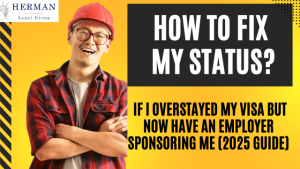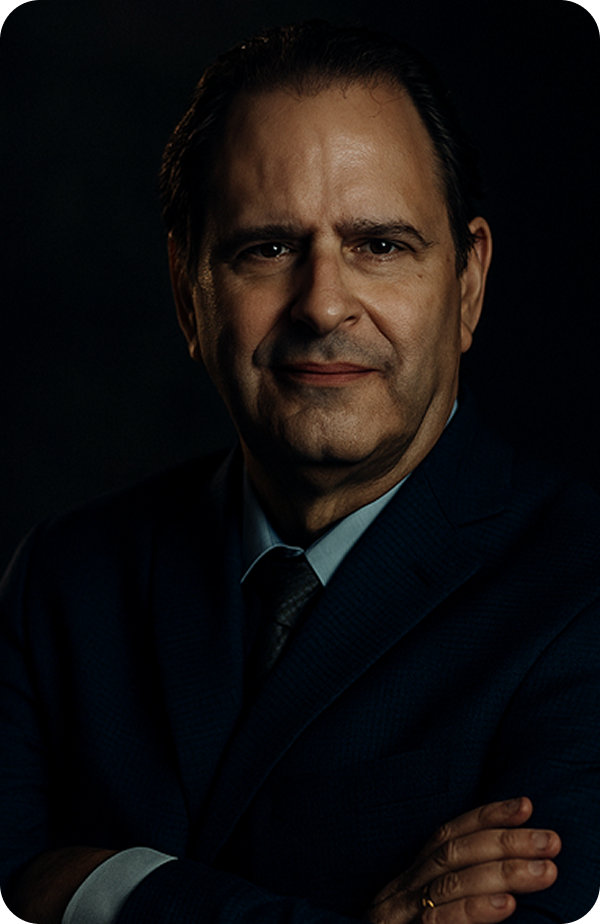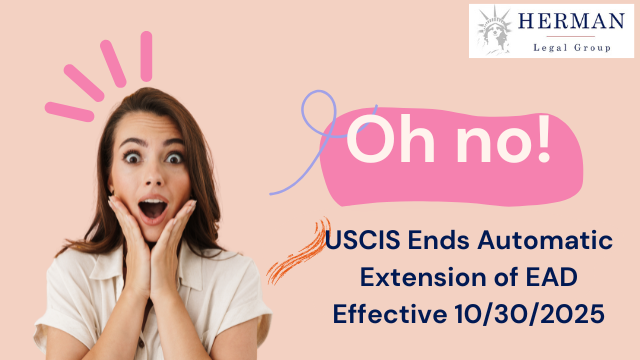By Richard T. Herman, Immigration Attorney – Herman Legal Group
Overstaying a visa means remaining in the United States beyond the expiration date of your authorized stay, as indicated on your I-94 record. This often happens when someone enters the U.S. on a nonimmigrant visa, such as a tourist, student, or work visa, and does not leave when their permitted time ends. Maintaining lawful entry and legal status is crucial for eligibility for most immigration benefits; individuals who entered the country legally and have preserved their legal status are more likely to qualify for adjustments or forgiveness related to visa overstays.
Understanding the Visa Overstay Problem
When you “overstay” your visa—whether a tourist, student, or work visa—you’ve stayed in the United States longer than your authorized period on your I-94 record. The authorized stay date or expiration date on your I-94 determines when you must leave the U.S. to avoid becoming unlawfully present. Once that date passes, you begin accruing unlawful presence, which can trigger 3-year or 10-year bars to reentry if you leave the U.S. Unlawful presence time begins to accrue the day after your authorized stay date or expiration date passes.
Fast Fact:
- Over 700,000 people per year overstay visas according to the DHS Entry/Exit Overstay Report.
- Even a short overstay can create long-term immigration consequences.
- Different rules apply depending on how long you have been unlawfully present, which can affect the penalties and bars to reentry.
If you now have an employer willing to sponsor you, that’s a positive development—but it doesn’t automatically erase your unlawful presence. You’ll need to understand which immigration paths remain open and which require waivers before you can “fix” your status. Your employer must be willing to support you through the new visa petition process.

What Does “Fixing My Status” Mean?
“Fixing your status” means obtaining lawful immigration status—usually through adjustment of status (AOS) or consular processing—so you can stay or return to the U.S. legally and eventually obtain a green card. Regaining eligibility for immigration benefits is a key goal of the status process, as it allows you to access legal pathways such as adjustment of status, employer sponsorship, and waivers. You may request a waiver of inadmissibility to pardon your unlawful presence when applying for a green card.
The immigration process for fixing status involves several steps, including employer sponsorship, waivers, and interviews.
Key Insight:
Overstaying your visa closes some options, but if your employer is ready to file an I-140 Immigrant Petition or another work-based petition, you may still have a path forward.
Employer Sponsorship Basics (2025 Overview)
Step 1: The I-140 Employer Petition
An employer can sponsor a worker through an I-140 immigrant petition after obtaining PERM Labor Certification (in most cases). This applies to EB-2 and EB-3 visa categories.
Step 2: The “Adjustment vs. Consular” Choice
| Path | Adjust in U.S. | Consular Processing |
|---|---|---|
| Eligibility | Must have lawful admission or parole (i.e., you were ‘lawfully admitted’—entered the U.S. through proper inspection and admission procedures) | Can be used after overstay (with caution) |
| Risk | Overstay often disqualifies | Departure may trigger 3/10-year bar |
| Timeline | ~12–24 months | ~9–18 months |
| Best For | Those lawfully present | Those abroad or barred from AOS |
To qualify for adjustment of status, you must not only be lawfully admitted or paroled, but also maintain your nonimmigrant status throughout the process. Losing nonimmigrant status due to overstay or violation can disqualify you from adjusting status in the U.S.
Important Note:
You cannot adjust status inside the U.S. if you entered lawfully but overstayedunless you fall under limited exceptions like INA §245(i) or parole-in-place. Overstaying your visa is considered a status violation, which can impact your eligibility for adjustment of status.
Most overstayers must depart the U.S. and process abroad—raising waiver issues.
Can I Adjust Status Inside the U.S. After an Overstay?
In Some Cases, Yes:
You may still adjust if:
- You were petitioned by a U.S. citizen spouse or parent (immediate relative exception).
- You qualify under INA §245(i) (old grandfathered cases). Section 245(i) allows a rare exception for applicants who were beneficiaries of a visa petition or labor certification filed on or before April 30, 2001.
- You have parole-in-place granting lawful presence.
In Most Employment-Based Cases, No:
Employment-based adjustment requires lawful admission and status. Overstaying breaks that rule.
Expert Tip:
If you entered legally (e.g., tourist visa), but overstayed, your employer can still file your I-140—you just can’t file your I-485 adjustment until you fix your status through consular processing or waiver.
The Unlawful Presence Bar and Waivers
If you leave the U.S. after accruing:
- 180 days of unlawful presence → 3-year bar
- 1 year + of unlawful presence → 10-year bar
The length of your unlawful presence time determines whether the 3-year or 10-year bar applies, and how long you may be inadmissible to the U.S.
That means if you attend your visa interview abroad, you could be denied reentry unless you obtain a waiver of inadmissibility. Exceptions apply in certain cases, and eligibility depends on your relationship to a qualifying family member and other individual circumstances.
Common Waivers:
- I-601A Provisional Waiver (filed before departure)
- I-601 Waiver (filed abroad post-refusal)
These require proving extreme hardship to a qualifying U.S. citizen or lawful permanent resident spouse or parent—not to your employer. To be approved for a Provisional Unlawful Presence Waiver (Form I-601A), you must prove that your U.S. citizen or lawful permanent resident spouse or parent would face “extreme hardship” if you were denied re-entry.
Key Insight:
Employer sponsorship alone does not qualify you for a waiver; you’ll need a qualifying family member.
Consular Processing Pathway (For Most Overstays)
If you can’t adjust inside the U.S., the route is:
- Employer files [LINK 1] + [LINK 2].
- Once approved, case moves to [LINK 3].
- Attend interview at your home-country U.S. consulate. The interview may take place at the US embassy or consulate, where a consular officer will review your visa application.
- If unlawful presence applies, file [LINK 4] first. Adjustment of status is only available to overstayers who have accrued less than 180 days of unlawful presence without serious consequences. In some cases, choosing to depart voluntarily before removal proceedings can reduce penalties and improve your chances of future reentry.
- Employer files PERM + I-140.
- Once approved, case moves to NVC.
- Attend interview at your home-country U.S. consulate. In some cases, choosing to depart voluntarily before removal proceedings can reduce penalties and improve your chances of future reentry.
- If unlawful presence applies, file I-601A waiver first.
Important Note:
Leaving the U.S. without a waiver triggers the bar automatically.
Labor Certification: The First Hurdle for Most Employment-Based Green Cards
For most foreign nationals seeking a green card through employment, labor certification is the essential first step—and often the most challenging. Required by the Immigration and Nationality Act (INA), labor certification is designed to protect U.S. workers by ensuring that hiring a foreign national will not negatively impact the job market, wages, or working conditions for American employees.
The process begins with your employer working closely with an experienced immigration attorney to navigate the complex requirements. The employer must conduct a thorough recruitment campaign to test the U.S. labor market, advertising the job and interviewing any qualified U.S. applicants. Only if no suitable U.S. worker is found can the employer move forward by filing a labor certification application with the Department of Labor. This application must also include a prevailing wage determination, confirming that the offered salary meets or exceeds local standards.
Once the Department of Labor approves the labor certification, your employer can file an immigrant petition (Form I-140) with U.S. Citizenship and Immigration Services (USCIS). This petition is a critical step toward obtaining an employment-based green card and ultimately achieving permanent residency in the United States.
If you have a history of visa overstays or have accrued unlawful presence, the stakes are even higher. Labor certification alone does not resolve issues related to your immigration status or past status violations. That’s why it’s crucial to consult an experienced immigration attorney early in the process. Your attorney can help you understand how your immigration history may affect your eligibility for adjustment of status, whether you need a waiver, and how to meet physical presence requirements under the INA and related immigration laws.
Labor certification is not just a bureaucratic hurdle—it’s a safeguard for both U.S. workers and foreign nationals. By following the correct procedures and working with a knowledgeable immigration attorney, you can maximize your chances of success and avoid costly mistakes or delays. Your attorney can also advise you on which employment-based green card category (EB-1, EB-2, or EB-3) best fits your qualifications and long-term goals.
In summary, labor certification is a foundational step in employment-based immigration. Understanding its requirements and working with an experienced immigration attorney can help you navigate the process, address any issues related to visa overstays or unlawful presence, and move closer to your goal of permanent residency in the United States.
Fast Fact:
As of 2025, USCIS processing times for I-601A waivers average 18–28 months, per USCIS Processing Times Tool.
At a Glance: Overstay Fix Options by Situation
Before reviewing the table, consider the following categories of overstay situations and their possible solutions:
| Situation | Possible Path | Waiver Needed? | Risk |
|---|---|---|---|
| Overstayed < 180 days | Adjustment (if eligible) | No | Low |
| Overstayed >180 days | Consular + Waiver | Yes | Moderate |
| Overstayed >1 year | Consular + Waiver | Yes | High |
| Overstayed but spouse/parent USC/LPR | Family adjustment | Possibly | Medium |
| Parole-in-place (military family) | Adjustment | Usually no | Low |
Other categories of visa holders or family members, such as children under 21 or parents of U.S. citizens, may have different options or exceptions depending on their specific circumstances.
Ohio Focus: Employer Sponsorship in Cleveland & Columbus
Ohio employers—from Cleveland Clinic to Nationwide Insurance—routinely sponsor foreign talent.
However, overstay cases require local immigration expertise.
Need to Know:
In 2025, national, Cleveland and Columbus USCIS Field Offices are closely reviewing unlawful presence histories and I-601A waivers.
Top Immigration Law Firms (2025 Comparison)
1. Herman Legal Group – Cleveland & Columbus, OH
Founded by Richard T. Herman, AV-Rated attorney with 30+ years experience in employment sponsorship, overstay waivers, and removal defense. When facing visa overstays or navigating employer sponsorship, consulting an experienced immigration lawyer is essential to understand your options and avoid serious legal consequences.
👉 Book Consultation
2. Bartell, Georgalas & Juarez, L.P.A. – Cleveland/Columbus full-service immigration firm.
3. Porter Law Office, LLC – Columbus boutique focusing on employment-based visas.
4. Shihab & Associates – Cleveland & Columbus firm specializing in business immigration.
5. Margaret W. Wong & Associates – National practice with experience in waivers and overstay relief.
Comparison Chart:
| Firm | Focus | Ohio Offices | Overstay Waiver Experience |
|---|---|---|---|
| Herman Legal Group | Employer + Family + Waivers | Cleveland & Columbus | 30+ years |
| Bartell Georgalas Juarez | Full Service | Cleveland & Columbus | Moderate |
| Porter Law Office | Business Immigration | Columbus | Moderate |
| Shihab & Associates | Employment Visas | Cleveland & Columbus | High |
| Margaret Wong & Assoc. | National | Multiple states | High |
Expert Tip:
When choosing counsel, ask: “What’s your I-601A waiver strategy and consular plan if my overstay triggers a bar?”
Checklist: How to Fix Status with Employer Sponsorship
| Step | Task | Who Handles It |
|---|---|---|
| 1 | Employer files PERM | Employer + Attorney |
| 2 | Employer files I-140 | Employer |
| 3 | File I-601A waiver (if needed) | You + Attorney |
| 4 | Attend consular interview | You |
| 5 | Re-enter with immigrant visa | You |
Essential Info:
Never leave the U.S. without a legal opinion confirming whether a bar applies.
Common Mistakes to Avoid
- Assuming sponsorship forgives unlawful presence – It doesn’t.
- Departing before waiver approval – Triggers 3/10-year bar.
- Filing I-485 without eligibility – Leads to denial.
- Not hiring an experienced immigration attorney – Waivers are technical and fact-sensitive.
Making these mistakes can result in deportation proceedings, where an immigration judge will decide your case.
Timeline & Costs (2025 Averages)
| Stage | Avg Time | Notes |
|---|---|---|
| PERM + I-140 | 12–24 months | Employer-led |
| I-601A Waiver | 18–28 months | Filed in U.S. |
| NVC + Interview | 6–12 months | Abroad |
| Total | ~4-5 years | Case dependent |
Fast Fact:
Premium Processing for I-140 petitions remains available in 2025 per USCIS.
When It Gets Complicated
- Removal Proceedings: If ICE places you in court, employer petitions don’t automatically pause removal. Certain individuals, such as green card holders, unmarried children under 21, DACA recipients, and lawful permanent residents, may have different options for obtaining permanent residence or United States citizenship depending on their specific circumstances.
- Criminal Records: May trigger inadmissibility.
- Unauthorized Work: Affects adjustment eligibility.
- Employer Compliance: Employers must meet I-9 and E-Verify standards. Eligibility for relief may depend on your current status as a green card holder or lawful permanent resident.
Frequently Asked Questions
Can my employer’s petition erase my overstay?
No. It opens a path but doesn’t cancel unlawful presence or bars.
Can I stay in the U.S. while waiting for waiver approval?
Yes—with an I-601A waiver—but don’t depart until approved.
Can I travel abroad during processing?
Not unless you have Advance Parole or an approved immigrant visa.
Does marriage to a U.S. citizen help?
Yes. Immediate relatives are often forgiven for certain overstays under INA §245(a).
What if my waiver is denied?
You may refile with stronger hardship evidence or request humanitarian parole.
Key Takeaways
- Overstaying your visa triggers unlawful presence bars.
- Employer sponsorship helps but doesn’t forgive overstay.
- Most need consular processing + I-601A waiver.
- Waivers require a U.S. citizen/LPR spouse or parent, not your employer.
- Do not leave the U.S. without legal counsel.
- Ohio’s Cleveland & Columbus offices scrutinize waivers heavily.
- Hire experienced immigration counsel before acting. Consulting an immigration attorney is the most critical first step when dealing with a visa overstay.
- The Herman Legal Group assists clients nationwide from Ohio offices.
Resources
- USCIS – Adjustment of Status
- USCIS – I-601A Provisional Waiver
- USCIS – I-601 Waiver
- Department of State – Immigrant Visa Process
- USCIS – Processing Times
- CBP – I-94 Admission Record
- Book Consultation – Herman Legal Group








Immigration Lawyer for Media Comment on Trump’s Immigration Policies — Richard T. Herman, Esq.